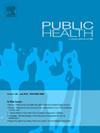The influence of the utilization of health insurance on the relationship between health shocks and poverty vulnerability among rural elderly in China: A study of different household structures
IF 3.9
3区 医学
Q1 PUBLIC, ENVIRONMENTAL & OCCUPATIONAL HEALTH
引用次数: 0
Abstract
Objectives
The study aimed to clarify the mechanism linking health shocks, health insurance utilization and poverty vulnerability among households of rural elderly in China, and explore the effect of household structure on the mechanism.
Study design
Cross-sectional study.
Methods
Data were obtained from an on-site survey supported by China's National Natural Science Foundation in 2022, targeting rural elderly with chronic diseases and their families. In total, 2169 Chinese rural residents aged ≥60 years with chronic diseases and their families were interviewed. Health shocks were represented as a latent variable comprising five specific variables. Health insurance usage was categorized into three options. Poverty vulnerability was assessed with a poverty line standard of $1.9 per capita daily consumption. Household structures were classified into three types. A structural equation model was constructed to explore the mechanism between these factors in the total study population and different household types. Entropy weight method assessed health shock scores. The Karlson-Holm-Breen (KHB) mediation decomposition method was applied to decompose the mediating effect of health insurance utilization in empty-nest and left-behind children's households.
Results
Findings showed that health insurance utilization mediates the link between health shocks and poverty vulnerability (a = 0.061, b = −0.01, c = 0.119; all P < 0.05). No mediation was observed in expand core households; however, in empty-nest and left-behind children's households, significant effects were seen (for empty-nest elder households, a = 0.032, b = −0.043, c = 0.078; for left-behind children's households, a = 0.066, b = −0.025, c = 0.123; all P < 0.05). The utilization of basic health insurance and medical financial assistance exhibits the highest mediation decomposition values among empty-nest and left-behind children's households, reaching 87.31 % and 64.89 %, respectively.
Conclusions
Health insurance utilization is crucial for countering health shocks and poverty vulnerability among rural households; however, its efficacy differs among household structures.
健康保险使用对中国农村老年人健康冲击与贫困脆弱性关系的影响——基于不同家庭结构的研究
目的研究中国农村老年人家庭健康冲击、医疗保险利用与贫困脆弱性之间的关联机制,并探讨家庭结构对该机制的影响。研究设计横断面研究。方法数据来源于中国国家自然科学基金2022年资助的一项现场调查,调查对象为农村慢性病老年人及其家庭。共访谈2169名60岁以上的中国农村慢性病患者及其家属。健康冲击被表示为包含五个特定变量的潜在变量。健康保险的使用分为三个选项。以人均每日消费1.9美元的贫穷线标准评估贫穷脆弱性。家庭结构分为三种类型。构建结构方程模型,探讨研究人群中这些因素与不同家庭类型之间的作用机制。熵权法评估健康休克评分。采用Karlson-Holm-Breen (KHB)中介分解方法对空巢和留守儿童家庭医疗保险使用的中介效应进行分解。结果健康保险利用在健康冲击与贫困脆弱性之间起中介作用(a = 0.061, b = - 0.01, c = 0.119;所有P <;0.05)。在扩大核心家庭中未观察到中介作用;然而,在空巢和留守儿童家庭中,效果显著(空巢老人家庭,a = 0.032, b = - 0.043, c = 0.078;对于留守儿童家庭,a = 0.066, b = - 0.025, c = 0.123;所有P <;0.05)。在空巢家庭和留守儿童家庭中,基本医疗保险和医疗资助利用的中介分解值最高,分别达到87.31%和64.89%。结论医疗保险的利用对农村家庭抵御健康冲击和贫困脆弱性至关重要;然而,它的功效因家庭结构而异。
本文章由计算机程序翻译,如有差异,请以英文原文为准。
求助全文
约1分钟内获得全文
求助全文
来源期刊

Public Health
医学-公共卫生、环境卫生与职业卫生
CiteScore
7.60
自引率
0.00%
发文量
280
审稿时长
37 days
期刊介绍:
Public Health is an international, multidisciplinary peer-reviewed journal. It publishes original papers, reviews and short reports on all aspects of the science, philosophy, and practice of public health.
 求助内容:
求助内容: 应助结果提醒方式:
应助结果提醒方式:


